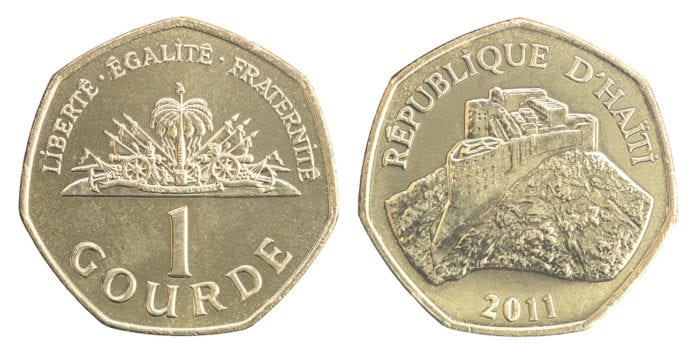Haitian gourde is used as currency in Haiti. Gourde is the French version of the word, but those who speak Haitian Creole use the word “Goud.” The French actually derived “gourde” from the Spanish word “gordo.” The Spanish used the term “pesos gordos” to describe physical pieces of eight during the colonial era. Since the Spanish were the first to influence Haiti, their word for currency continued to remain in some capacity.
The standard abbreviation of Haitian gourde is HTG. Anything less than one gourde is called a centime. For instance, 100 centimes are equal to one gourde. It is similar to how 100 pennies are equal to one U.S. dollar. All of the banknotes issued for the currency include 10 HTG, 20 HTG, 25 HTG, 50 HTG, 100 HTG, 250 HTG, 500 HTG, and 1,000 HTG.
There are smaller banknotes for 1 HTG, 2 HTG, and 5 HTG, but they are hardly used anymore because they’re practically worthless. After all, 105 HTG is equal to 1 USD. That means one HTG is equal to about one cent. How much can you really buy these days with only one cent? So, the Haitians don’t even bother using bills that are worth less than 10 HTG.
Of course, if change ever needs to be made for a purchase, there are coins that can further break down 1 HTG into centimes. There are coins for 5 centimes, 10 centimes, 20 centimes, and 50 centimes. The poorest Haitians are the most common ones to make purchases with stacks of coins that they save.

About the Haitian Gourde
The Haitian Government used to align the worth of the Haitian Gourde with the French franc. But as the Haitians achieved independence from France, the Bank of the Republic of Haiti was established to manage the country’s own currency and to create a monetary policy for Haiti that was separate from France’s monetary policy.
Unfortunately, that may have been a mistake. Haiti is a very poor country, so most people in the country don’t even have much Haitian Gourde to begin with. Outside of Haiti, there is virtually no demand for Haitian Gourde anywhere. It is not traded on any currency exchange, so investments into the currency are almost null. What’s worse is that Haiti does not produce much of anything in trade.
Agriculture is the only industry in Haiti that actually produces something. The people only farm for their own survival. They don’t usually bother trying to sell their produce for money because most people in the country cannot afford to purchase anything. It is much cheaper for Haitians to grow their own food than it is to purchase it. The only exception is if a Haitian tries to sell their food to a foreigner or tourist.
All the Haitians that are not farmers have to depend on foreign aid from the United States in order to survive. This explains why the Haitian Gourde is so worthless to the rest of the world. There is no value behind the gourde because the country offers nothing of value to the world.
In fact, it is billions of dollars in debt because of all the money it borrows on top of the aid. In 2009, the World Bank and the International Monetary Fund offered to forgive over $1 billion of outstanding debt owed by the Haitian Government. This was an effort to relieve the government and to save the gourde from being too worthless.
The Origins of the Gourde
In 1813, the Haitian Gourde was established for the country of Haiti. It was a new currency that was meant to replace the previous Haitian currency called livre. The Haitian livre was actually established by the French colonialists who took over Haiti before it was an independent country.
The Haitian livre had the same value as the French livre. One livre was equal to 20 sous, with 15 sous having the value of one Spanish real. The Spanish colonialists used their “real” currency when they enslaved the indigenous Taino people of Haiti before the French came along. They continued to use the currency after leaving Haiti as well.
When the Haitians got their independence from France in 1804, they eventually wanted to reinvent the currency of the land. So, they got rid of the livre and replaced it with the gourde. The Haitian gourde has continued to be used ever since 1813. The Haitian government considered the creation of the Haitian gourde as one more symbol of their independence.
One gourde is the equivalent of 8 livres and 5 sous. The Haitians purposely inflated the value of their currency because they wanted to downgrade the value of the French currency. As a result, the exchange rates made currency conversions a lot more difficult throughout the 19th century. This prompted France to make the French franc its primary currency instead of the livre. But the gourde continued to exceed the value of the franc, with a rate of one gourde equal to five French francs.
Unfortunately, the Haitian Gourde did not prosper against the United States Dollar in the 20th century. By the year 1912, five gourdes were equal to 1 USD. The economic conditions of Haiti continued to get worse, causing the value of the gourde to decrease even further. Now 1 USD is equal to 105 Haitian gourdes. That should give you an idea of how badly the Haitian economy has plummeted.

